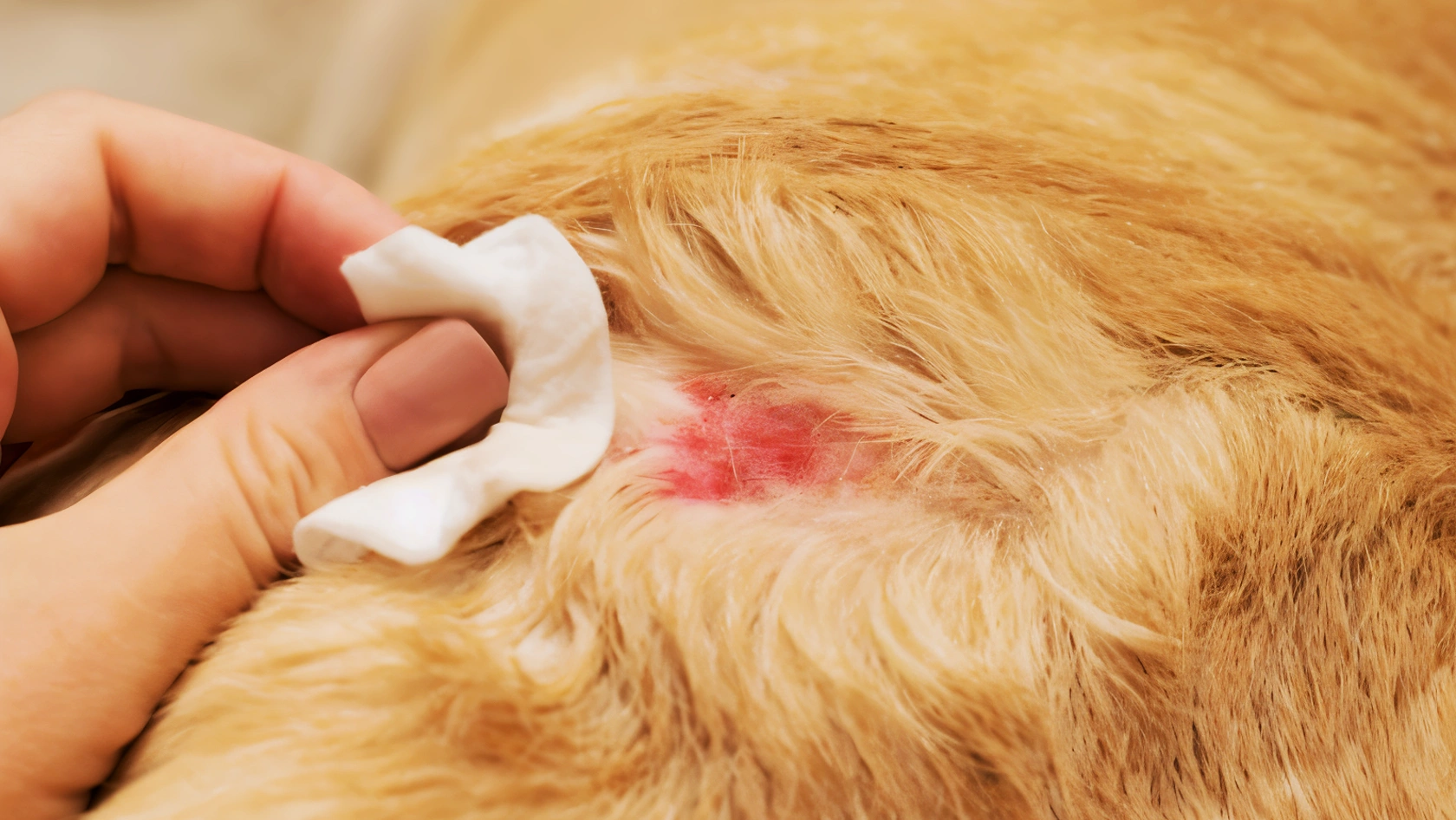TL;DR: Quick Guide to Dog Hot Spots – Causes, Signs, and Home Care
- Hot spots or acute moist dermatitis are sore, red, and inflamed patches that can show up almost overnight.
- Dogs can get hot spots from allergies, fleas or ticks, getting wet without drying properly, underlying skin conditions, or from licking and scratching the same area too much.
- Breeds with thick coats or skin folds, like Golden Retrievers, Labradors, German Shepherds, Huskies, Bulldogs, Shar-Peis, and Akitas, are more likely to develop hot spots.
- Watch for signs like red or raw skin, hair loss, swelling, warmth, a bad smell if infected, and dogs constantly licking or scratching the hot spot.
- At home, you can gently clean the area, keep it dry, use vet-approved sprays for dogs, and try to stop your dog from licking or scratching the sore.
- Visiting the vet for proper diagnosis and treatment helps the hot spot heal and lowers the chance of recurring hot spots.
- Regular grooming, keeping your dog’s skin and coat healthy, managing allergies, and paying attention to small irritations can help prevent hot spots from occurring.
If you notice any signs of hot spots or think your dog might need extra care, get in touch with our team. We’re here to help keep your dog comfortable, healthy, and happy. Taking action early can make a big difference and help prevent recurring hot spots.
Ever found a sore, red patch on your dog’s skin that showed up overnight? That’s a hot spot on your dog, also called acute moist dermatitis, and it’s a common skin problem. Finding the underlying cause of the hot spot is the first step to helping your dog heal.
Hot spots in dogs can appear suddenly and spread fast. A dog may get hot spots from allergies, scratching, or other skin issues. Knowing what causes hot spots on dogs makes it easier to prevent hot spots in the future.
The cause of your dog’s hot spot may change, but the right hot spot treatment for dogs brings relief. With proper care, you can treat hot spots on dogs and lower the risk of them coming back. Keep reading to learn the signs, causes, and treatments.
Understanding Dog Hot Spots: What Is a Hot Spot on a Dog?
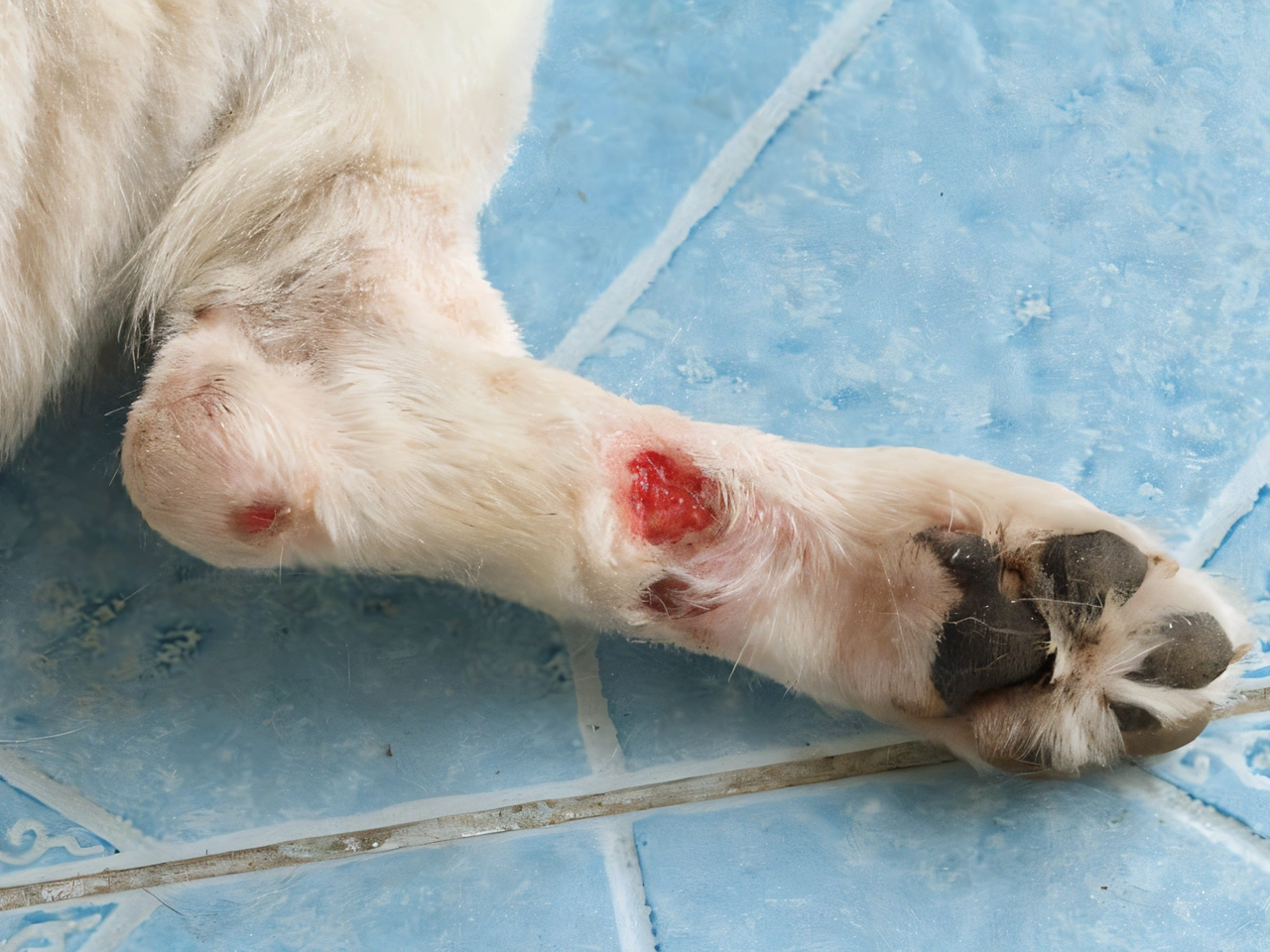
If you’ve ever noticed a red, sore patch on your dog’s skin that seems to get worse overnight, you may have seen a hot spot.
Hot spots on dogs, also called acute moist dermatitis, are one of the most common skin conditions in dogs. A hot spot is usually a painful, irritated area of skin that can quickly turn into a skin infection if not cared for.
What Is a Dog Hot Spot?
A hotspot is essentially a patch of skin that becomes red, moist, and inflamed. Hot spots can appear suddenly, often when dogs lick or scratch the same spot too much. Once the skin is broken, bacteria spread around the hot spot, which can result in a larger hot spot or even a secondary hot spot nearby.
Where Do Hot Spots Usually Appear?
Hot spots often occur in places where the skin stays damp or warm. You might notice them around the ears, under the collar, on the belly, or near the tail. The tricky part is that the area around the hot spot can spread quickly if you don’t treat the hot spots right away.
Dog Breeds Prone to Developing Hot Spots
While many dogs can get hot spots, some are more prone to developing hot spots because of their coat type, allergies, or skin folds.
Breeds with thick coats:
- Golden Retrievers
- Labrador Retrievers
- German Shepherds
- Huskies
- Newfoundlands
- Rottweilers
- St. Bernards
Breeds with skin folds or allergies:
- Pugs
- Bulldogs (English and French)
- Shar-Pei
- Akitas
Why are these dogs more at risk?
- Trapped moisture: Dense coats or folds hold heat and moisture, which can lead to hot spots.
- Underlying skin conditions: Allergies and skin problems often lead to hot spots.
- Dogs lick or scratch: Constant scratching of the hot spot or licking the skin can make things worse.
Why Hot Spots Can Appear Suddenly
Hot spots can appear suddenly and seem to grow almost overnight. If a dog gets wet and the skin doesn’t dry properly, the risk of hot spots goes up. Without the right treatment plan, recurring hot spots may develop, making both you and your dog frustrated.
Triggers and Irritants: What Causes Hot Spots on Dogs?
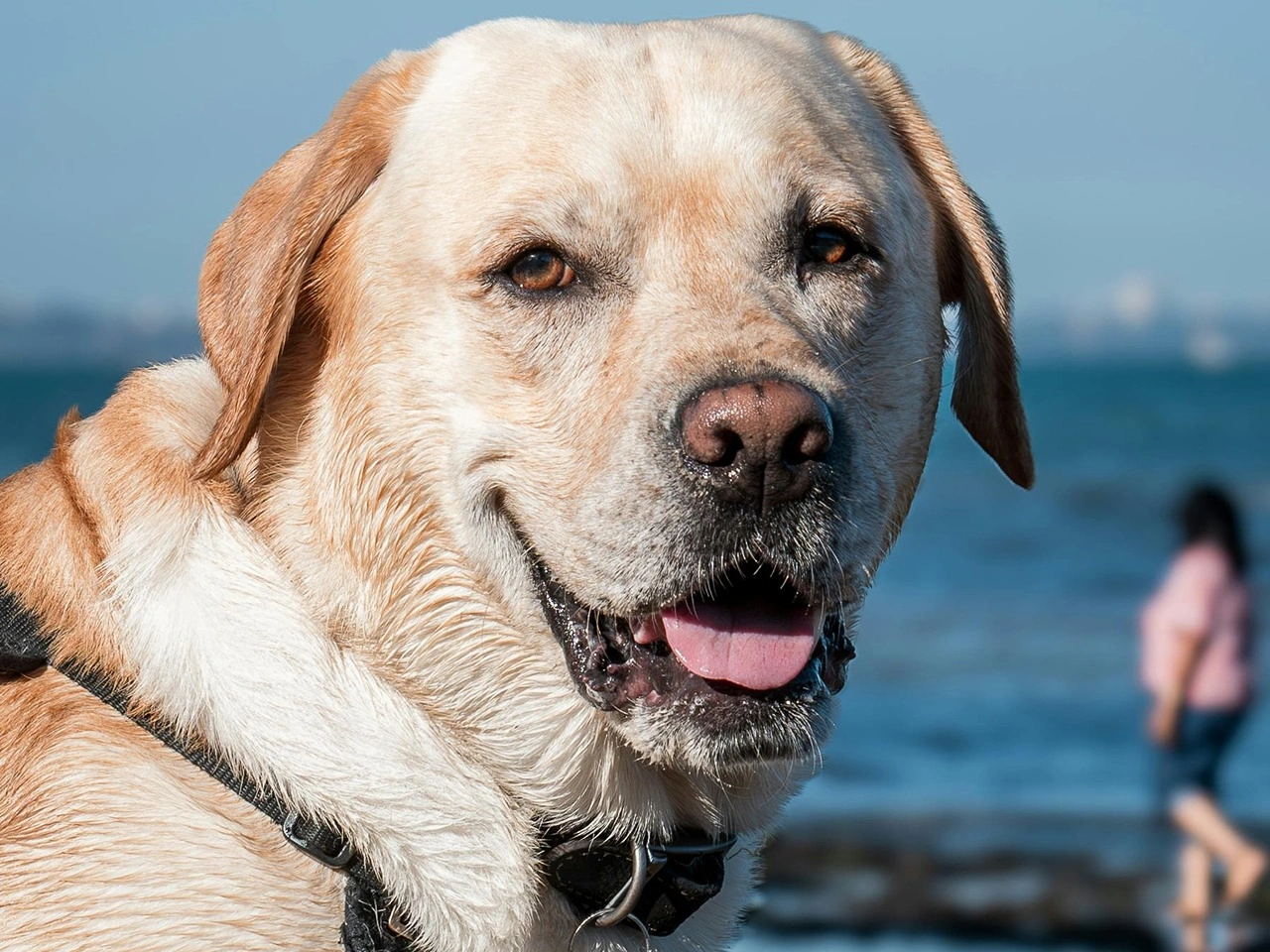
Hot spots are one of the most common skin problems dogs face, but they don’t just appear out of nowhere. Spots on dogs are caused by something that irritates the skin and makes them lick, chew, or keep scratching the hot spot until it turns raw.
Knowing what causes hot spots on dogs is the key to preventing hot spots from occurring and making sure your dog feels better.
Common Reasons Dogs Get Hot Spots
Hot spots are typically connected to anything that makes your dog’s skin itchy or uncomfortable. Once dogs are scratching the hot spot or licking the same area over and over, it can quickly result in a hot spot that spreads.
Some of the most common triggers include:
- Allergies – food or pollen allergies are one of the biggest causes of inflammation that lead to hot spots.
- Parasites – fleas or ticks irritate the skin and can lead to recurring hot spots.
- Moisture – developing hot spots due to a dog swimming or getting wet and not drying fully.
- Underlying skin conditions – chronic skin problems or infection increase the risk of hot spots.
- Behavioural issues – anxious or bored dogs lick the same spot until it results in a hot spot.
How Small Irritations Lead to Hot Spots
Hot spots often start with something small. It could be an itchy flea bite, a bit of rubbing under a collar, or even a tiny scratch. Without proper diagnosis and treatment of the underlying problem, that irritation causes inflammation and quickly turns into a hot spot—and sometimes even a secondary hot spot around the sore.
How to Identify Symptoms of Hot Spots in Dogs
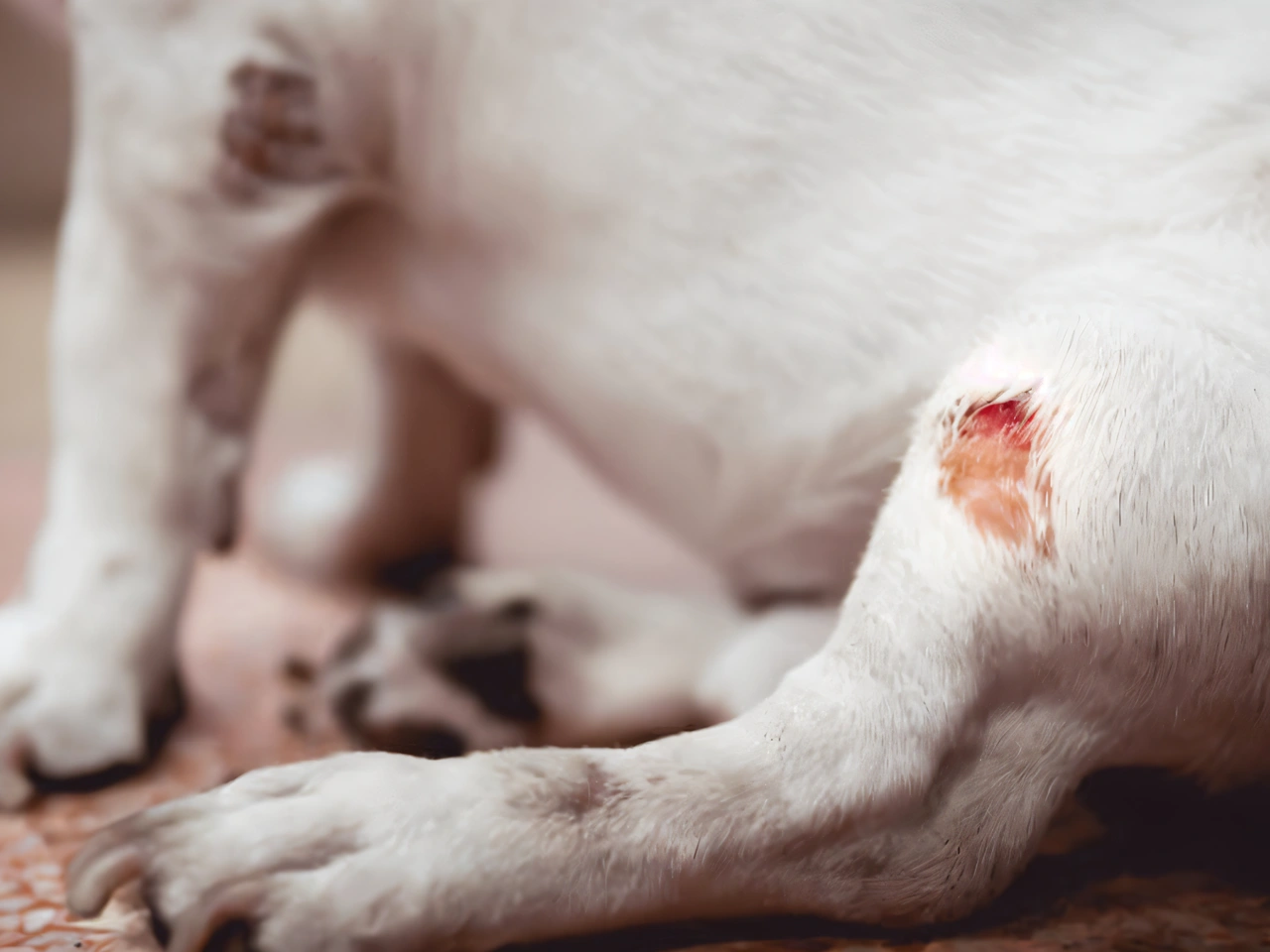
Hot spots are one of those skin conditions that can appear out of nowhere and make your dog really uncomfortable. Dogs are susceptible to them, and because hot spots can spread so quickly, it’s important to identify a hot spot early.
Once you know the signs of hot spots, you can stop your dog from licking and scratching the hot spot nonstop and get treatments and prevention in place before things get worse.
Physical Signs of Hot Spots
When a hot spot shows up, you’ll usually notice changes on your dog’s skin first. Some of the most common signs of hot spots are:
- Red, raw, and inflamed area of skin.
- Hair loss around the hot spot.
- Moist, oozing, or crusty patches that look painful.
- Swelling and warmth are coming from the sore.
- A bad smell if infection develops.
- Pain when you touch the area around the hot spot.
- The sore seems to grow quickly, sometimes in just a day or two.
Behavioural Signs of Hot Spots
Sometimes your dog’s behaviour gives you clues before the hot spot is obvious. Watch for:
- Dogs tend to lick or chew the same spot constantly.
- Scratching the hot spot until the skin breaks.
- Restlessness, whining, or acting more irritable.
- Ignoring food or toys because of the irritation.
- Trying to stop you from touching near the sore.
- Dogs lick even when you try to distract them.
Why Spotting Hot Spots Early Matters
The earlier you identify a hot spot, the easier it is to help prevent hot spots from spreading. Safe spray for dogs, medications, and treatment of the underlying cause are often part of a proper diagnosis and treatment plan from your vet. Avoid anything toxic to dogs and stick with products meant for pets. Knowing the signs of hot spots and acting quickly is the key to preventing hot spots from occurring again and helping your dog heal faster.
How to Prevent Hot Spots on Dogs Before They Start

Hot spots can be uncomfortable and painful, but with a little attention, many can be avoided. Keeping your dog’s skin healthy and spotting small irritations early makes a big difference. Paying attention to your dog’s coat, habits, and comfort is the best way to reduce the risk of hot spots.
Keep Your Dog’s Skin and Coat Healthy
A healthy coat is one of the easiest ways to prevent hot spots.
- Brush your dog often to prevent mats that trap moisture.
- Dry your dog thoroughly after a bath or when your dog swims.
- Use shampoos that are safe for dogs.
- Check for fleas, ticks, or parasites that can lead to a hot spot.
Stop Dogs From Licking and Scratching
Dogs licking or scratching the hot spot can make it worse very quickly.
- Use an e-collar or protective covering to keep your dog from licking.
- Give toys or activities to distract your dog from chewing or licking.
- Ask your vet about a spray for dogs that soothes irritation.
Watch for Signs of Hot Spots Early
Catching a hot spot early can save your dog a lot of discomfort.
- Learn how to treat hot spots by noticing redness, wet patches, or irritation.
- Identify a hot spot quickly and keep your dog from licking or scratching it.
- Get proper diagnosis and treatment if the spot is caused by allergies, parasites, or skin infections.
Address the Underlying Causes
Hot spots usually happen because of another problem, so fixing the root cause helps prevent them.
- Manage allergies or skin conditions that cause inflammation.
- Keep up with flea and tick prevention all year.
- Make sure your dog’s environment and bedding stay clean and dry.
Work With Your Veterinarian
Your vet is the best guide for keeping hot spots from coming back.
- Follow a vet-approved treatment plan for each hot spot.
- Use only products recommended by your vet to avoid anything toxic to dogs.
- Regular checkups help ensure each hot spot resolves fully and reduce the risk of recurring hot spots.
Easy Remedy Tips for Treating Hot Spots on Dogs at Home
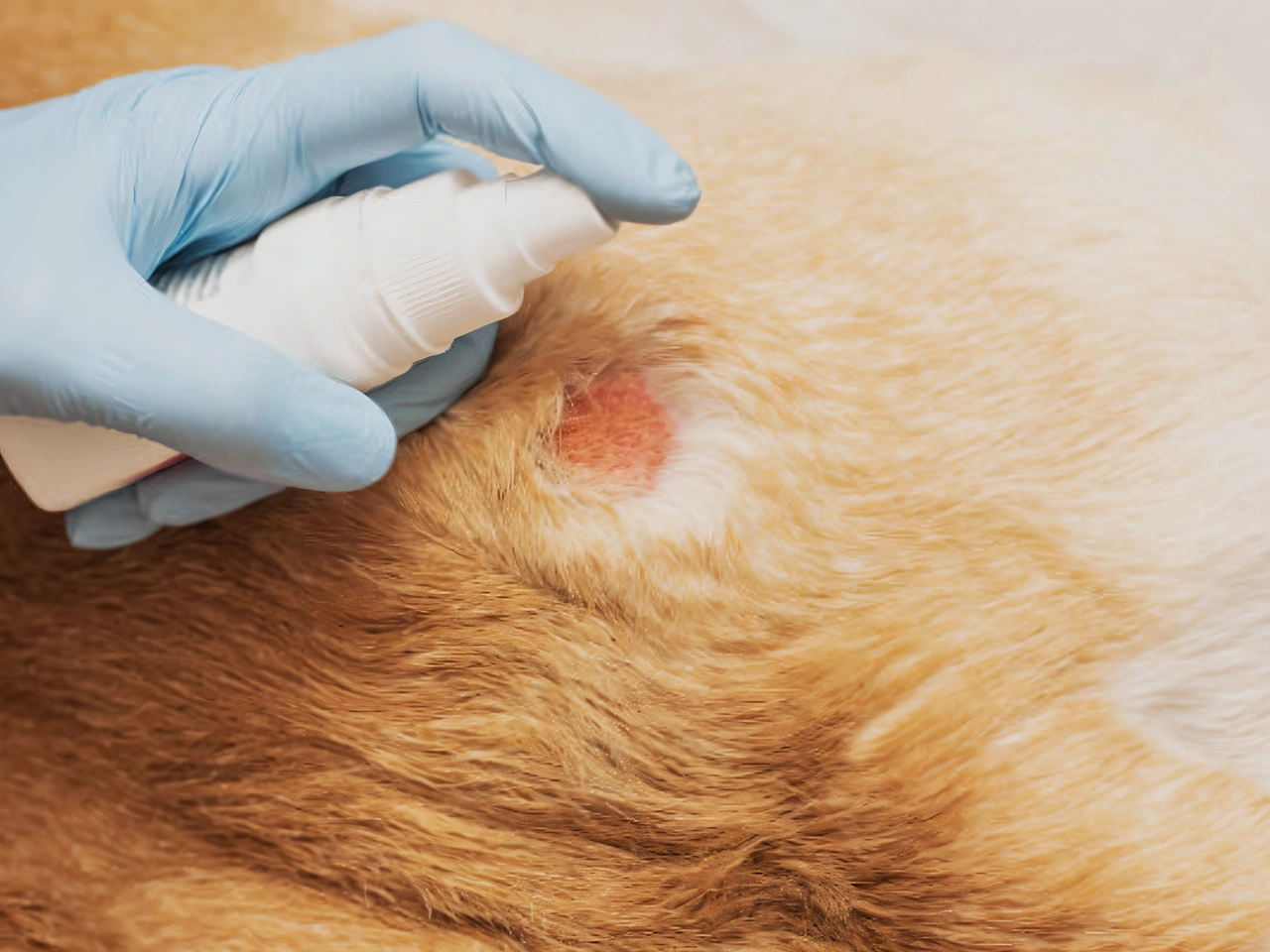
Hot spots can be painful, but simple home care can help your dog feel better fast. While these tips don’t replace proper diagnosis and treatment, they can reduce irritation and stop your dog from making the sore worse.
- Clean the area gently – Carefully trim hair around the hot spot and clean the skin with a mild antiseptic recommended by your vet.
- Stop dogs from licking the hot spot – Use an e-collar or breathable covering to prevent your dog from licking or scratching the hot spot.
- Soothing sprays for dogs – A vet-approved spray can calm inflammation and irritation safely for dogs.
- Keep the area dry – Moisture can make the hot spot worse, so gently pat the skin around the hot spot dry.
- Avoid toxic substances – Never use human creams or products that could be toxic to dogs.
- Watch for infection signs – Swelling, pus, foul odour, or spreading redness means it’s time for urgent veterinary attention.
- Offer comfort and distraction – Short walks, gentle petting, or toys can help keep your dog from licking or scratching.
- Be consistent – Treat the hot spot daily until it resolves, which helps prevent recurring hot spots.
Effective Hot Spot Treatment for Dogs: From Care to Recovery

Seeing your dog struggle with a hot spot can be upsetting, but with the right care, they can feel comfortable again quickly. Hot spots usually heal well when you combine proper diagnosis with consistent care at home. Knowing the steps from start to finish can help your dog recover faster and prevent recurring hot spots.
- Get a proper diagnosis and treatment – Take your dog to the vet to find out the underlying cause of the hot spot. This ensures treatments and prevention are effective and safe for dogs.
- Clean and care for the sore – Trim the hair around the hot spot carefully and clean the area following your vet’s instructions.
- Prevent licking and scratching the hot spot– Use an e-collar or protective cover to stop your dog from licking or scratching the hot spot, which can make it worse.
- Follow vet-recommended medications – Topical ointments, sprays for dogs, or oral medications may be prescribed to reduce inflammation and fight infection.
- Monitor the hot spot closely – Keep an eye on the sore for swelling, pus, or spreading redness, which may require further veterinary care.
- Treat the underlying cause – Allergies, parasites, or skin conditions can lead to hot spots, so managing them helps prevent recurrence.
- Provide comfort and distraction – Gentle petting, toys, or short walks can keep your dog calm while the hot spot heals.
- Maintain hygiene and environment – Clean and dry bedding, along with regular grooming, helps reduce the risk of hot spots from occurring again.
Final Thoughts
Hot spots on dogs can show up suddenly and make your furry friend really uncomfortable. Knowing the causes, signs, and triggers helps you catch them early and keep your dog’s skin healthy.
Acting quickly with the right care can stop a hot spot from spreading or coming back. Simple home remedies, along with vet-approved treatments, can make your dog feel better fast.
Keeping up with grooming, managing allergies, and looking after your dog’s coat can lower the chances of future hot spots. If you notice any signs or need advice, reach out to our team—we’re here to help keep your dog happy, healthy, and comfortable.
Frequently Asked Questions
Why do dogs get hot spots, and what makes them worse?
Hot spots happen when your dog’s skin gets irritated, inflamed, or infected, and certain habits or conditions can make them worse.
Allergies: Food, pollen, or flea allergies can make your dog’s skin itchy and inflamed.
Parasites: Fleas, ticks, or mites can trigger hot spots and make them worse.
Moisture: Wet skin from swimming or baths that isn’t dried properly can become a breeding ground for bacteria.
Scratching and licking: Dogs can make the sore worse by constantly licking or scratching the hot spot.
Underlying skin conditions: Chronic skin problems can make your dog more susceptible to developing hot spots.
Behavioural triggers: Stress, boredom, or anxiety can cause obsessive licking that results in a hot spot.
Are some dog breeds more prone to getting hot spots than others?
Some dogs are just more likely to develop hot spots because of their coat, skin folds, or genetics.
Thick-coated breeds: Golden Retrievers, Labradors, German Shepherds, Huskies, Newfoundlands, Rottweilers, and St. Bernards often get hot spots after swimming or in humid weather.
Skin-fold breeds: Bulldogs, Pugs, Shar-Peis, and Akitas can trap moisture in their folds, which leads to inflammation and sores.
Why they’re at risk: Dense coats and skin folds hold heat and moisture, while allergies or skin problems make the skin more prone to irritation.
Stay vigilant: Knowing your dog’s breed risk helps you spot a hot spot early and keep your dog comfortable.
What are the common symptoms of canine hot spots that owners should look for?
Spotting a hot spot early can save your dog a lot of discomfort and prevent the sore from spreading.
Red, raw, or inflamed skin: This is usually the first sign.
Hair loss around the hot spot: Fur may fall out near the irritated area.
Moist, oozing, or crusty patches: The skin can look wet, scabbed, or painful.
Swelling and warmth: The area may feel hot to the touch.
Foul odour: Infection can cause a noticeable smell.
Behavioural signs: Dogs may lick, chew, or scratch the spot constantly, act restless, whine, or avoid being touched near the sore.
What is the best way to treat a hot spot, and when should a vet be involved?
Proper treatment tackles both the sore and the cause to help your dog feel better fast.
Vet diagnosis: Your vet can identify what’s causing the hot spot and suggest the right treatment plan.
Clean and dry the area: Trim hair around the hot spot and gently clean the skin as instructed by your vet.
Stop licking and scratching: Use an e-collar or protective cover to prevent your dog from making the sore worse.
Vet-approved treatments: Topical sprays, ointments, or oral medications reduce inflammation and fight infection.
Monitor the sore: Keep an eye on swelling, pus, or spreading redness, which may require additional vet care.
Treat the underlying cause: Managing allergies, parasites, or skin conditions lowers the chance of recurring hot spots.
How effective is preventing hot spots in dogs with proper care and treatment?
With the right care, preventing hot spots is very effective and keeps your dog comfortable.
Regular grooming: Brushing your dog helps remove mats that trap moisture and irritate the skin.
Dry after baths or swimming: Damp skin creates a perfect environment for hot spots.
Manage allergies: Controlling food, flea, or environmental allergies reduces inflammation.
Catch them early: Identifying a hot spot quickly allows treatments and prevention to work faster.
Stop excessive licking: Keeping dogs from scratching or licking minor irritations prevents them from becoming hot spots.
Consistent care: Following a proper treatment plan for past hot spots helps reduce the risk of recurring hot spots.

